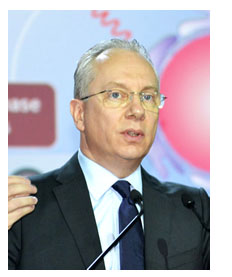 |
 |
 |
| |
Clinicians Have Multiple First-line Options for Treating HCV; Challenge is Implementation: all patients have right to be treated
|
| |
| |
Posted By: AASLD on: November 15, 2015
http://www.livermeetingtoday.org/clinicians-have-multiple-first-line-options-for-treating-hcv-challenge-is-implementation/
A succession of discoveries has led to infection cure rates of better than 90% in the quarter century since the discovery of the hepatitis C virus (HCV).
From Jules: one point not discussed by Dr Pawlotsky is that in the US medicaid & commercial insurers are not delaying access to therapy for IDUs but they are denying access, refusing to treat them, often unless they complete what is perhaps an illegal requirement to provide a urinalysis or go into rehab for 6 months or longer; a ridiculous requirement.

Jean-Michel Pawlotsky, MD, PhD
At Session I of the AASLD Postgraduate Course on Saturday, Jean-Michel Pawlotsky, MD, PhD, of the Henri Mondor University Hospital, University of Paris-Est, in France, reviewed the four direct-acting anti-viral (DAA) drugs now available and how those drugs are used in a trio of interferon (IFN)-free combinations to treat and cure HCV. International guidelines no longer recommend treatments containing IFN as first-line therapy.
"Notwithstanding the respective costs of these options, IFN-free regimens are the best options when available because of their virological efficacy, ease of use and tolerability," Dr. Pawlotsky said.
NS3-4A protease inhibitors (first-wave telaprevir, boceprevir; second-wave simeprevir, paritaprevir/r, asunaprevir and vaniprevir) shut the virus life cycle. NS5A inhibitors (daclatasvir, ledipasvir, ombitasvir ; second-wave elbasvir, velpatasvir) disorganize the replication complex and also block the assembly and release of viral particles.
Non-nucleoside inhibitors (dasabuvir) indirectly block RNA replication. Nuceotide analogues (sofobuvir) lead to chain termination after being incorporated into newly synthesized viral RNA.
From these four groups come the three current strategies for HCV treatment, and Dr. Pawlotsky said he didn't see many new treatments on the horizon.
The first strategy uses a nucleotide analogue with a high barrier to resistance that serves as the backbone of treatment with one of the drugs that has a low resistance barrier, either a protease inhibitor or an NS5A inhibitor such as ledipasvir or declatasvir.
The second option combines three drugs with low barriers to resistance - protease inhibitor, NS5A inhibitor and non-nucleoside inhibitor - to increase the barrier to resistance as a group. A current therapeutic example is the combination of paritaprevir, ombitasvir, and desaburvir.
The third strategy involves the use of one second-generation drug that has an improved barrier to resistance in combination with another drug. One such combination, the second-generation protease inhibitor grazoprever with the second-wave NS5A inhibitor elbasvir, should be approved in the coming months, Dr. Pawlotsky said.
The HCV guidance document published this year by AASLD and IDSA along with the EASL document also from 2015 recommends that those with chronic HCV infection should get treatment.
Every patient, Dr. Pawlotsky said, has by basic principle the right to be treated. But both cost of treatment and, more importantly, the number HCV patients mean not everybody can have access to treatment in the next year or two.
"There has been some misunderstanding of the term prioritization," he said. "When you prioritize patients, you don't deny therapy to the ones who are not treated immediately. You just say that these other patients need to be treated now. The other ones have the right to be treated, and they will be treated later."
Despite the recommendation for treatment of nearly all patients with HCV infection, Dr. Pawlotsky said, it remains important for clinicians to understand patient- and disease-related factors that place individuals at risk for HCV-related complications as well as for HCV transmission.
"Implementation is a big issue," Dr. Pawlotsky said. "Most of us come from countries where medicine is accessible, drugs are reimbursed and covered. This isn't true everywhere. This disease infects 150 million people worldwide, and we have to, by all means, provide access to these therapies to everybody in the world who is infected. Everybody has a right to be treated."
|
| |
|
 |
 |
|
|